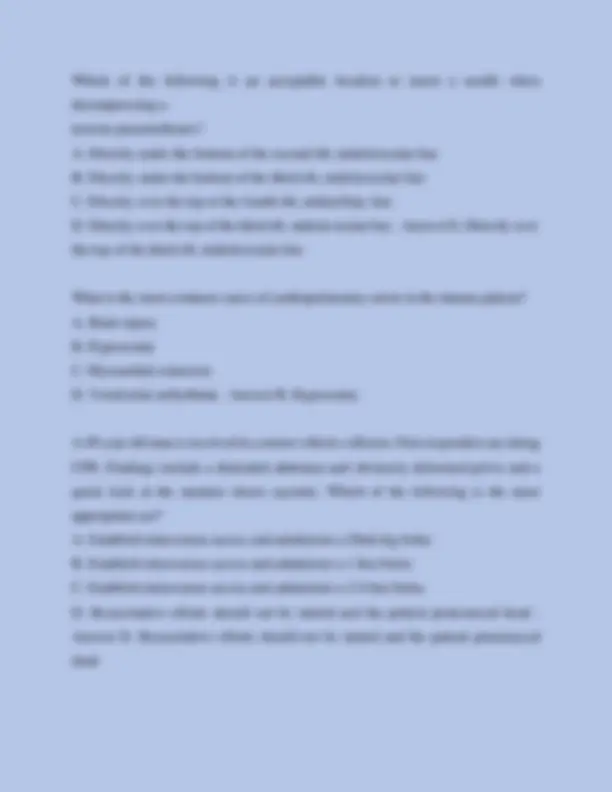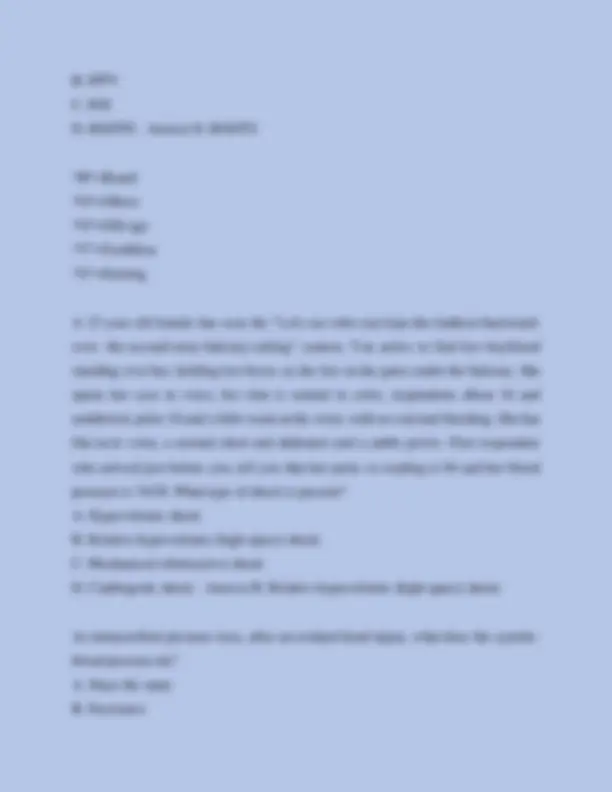











Study with the several resources on Docsity

Earn points by helping other students or get them with a premium plan


Prepare for your exams
Study with the several resources on Docsity

Earn points to download
Earn points by helping other students or get them with a premium plan
Community
Ask the community for help and clear up your study doubts
Discover the best universities in your country according to Docsity users
Free resources
Download our free guides on studying techniques, anxiety management strategies, and thesis advice from Docsity tutors
A series of practice questions and answers related to the advanced trauma life support (atls) course. It covers key concepts in trauma management, including airway management, hemorrhage control, shock, and burn care. The questions are designed to test knowledge and understanding of atls principles and procedures.
Typology: Exams
1 / 15

This page cannot be seen from the preview
Don't miss anything!










Definitive control of the airway is achieved by Endotracheal intubation
What metabolic state can result from continued hemorrhage or decreased perfusion?
B. Intravenous fluid at 20 ml/kg bolus C. Fentanyl 100 mcg intravenous D. Insert an oropharyngeal airway and assist ventilations - Answer A. Intravenous fluid at a "keep open" rate What is Sellick's maneuver? A. A method allowing the rescuer to hold a mask on the face with both hands B. A system used to calculate minute volume C. Another name for Mallampati D. Posteriorly directed pressure applied to the cricoid cartilage - Answer D. Posteriorly directed pressure applied to the cricoid cartilage A 16 year old girl is rescued from a burning house. She has 25% partial thickness burns, and the burned areas are hot to the touch. What is the appropriate treatment? A. Apply ice to burned areas until cool to touch B. Apply clean water to burned areas for up to 1 - 2 minutes C. Apply iced water to burned areas until cool to touch D. Do not apply anything to burned areas other than clean sheets - Answer B. Apply clean water to burned areas for up to 1 - 2 minutes What treatment is NOT indicated in the routine management of the patient with a head injury? A. Administration of 100% oxygen B. Fluid resuscitation to a BP of 110 - 120 systolic if the patient is hypotensive C. Hyperventilating to obtain an EtCO2 of less than 30 D. Stabilization of the cervical spine - Answer C. Hyperventilating to obtain an EtCO2 of less than 30
C. Intravenous fluid at a wide open rate; give at least two liters, then reassess patient D. No intravenous access should be established in this situation - Answer B. Apply a hemostatic agent and gain intravenous access given enough fluid to maintain peripheral pulses Which one of the following is typically associated with, post-traumatic hemorrhage, EARLY shock? A. Ventricular dysrhythmias B. Hypotension C. Loss of 30% to 45% of blood volume D. Narrowed pulse pressure - Answer D. Narrowed pulse pressure Among the following, what is the most common cause of preventable trauma death in the injured adult patient? A. Airway obstruction B. Cardiac tamponade C. Hemorrhagic shock D. Spinal injury - Answer C. Hemorrhagic shock Which of the following is most typical of early, neurogenic shock? A. Increased pulse, clammy skin B. Increased pulse, warm and dry skin C. Decreased pulse, clammy skin D. Decreased pulse, warm and dry skin - Answer D. Decreased pulse, warm and dry skin (skin is warm due to vasodilation)
Which of the following is an acceptable location to insert a needle when decompressing a tension pneumothorax? A. Directly under the bottom of the second rib, midclavicular line B. Directly under the bottom of the third rib, midclavicular line C. Directly over the top of the fourth rib, midaxillary line D. Directly over the top of the third rib, midclavicular line - Answer D. Directly over the top of the third rib, midclavicular line What is the most common cause of cardiopulmonary arrest in the trauma patient? A. Brain injury B. Hypoxemia C. Myocardial contusion D. Ventricular arrhythmia - Answer B. Hypoxemia A 49 year old man is involved in a motor vehicle collision. First responders are doing CPR. Findings include a distended abdomen and obviously deformed pelvis and a quick look at the monitor shows asystole. Which of the following is the most appropriate act? A. Establish intravenous access and administer a 20mL/kg bolus B. Establish intravenous access and administer a 1 liter bolus C. Establish intravenous access and administer a 2 - 4 liter bolus D. Resuscitative efforts should not be started and the patient pronounced dead - Answer D. Resuscitative efforts should not be started and the patient pronounced dead
A. Hypovolemic shock B. Relative hypovolemic (high-space) shock C. Mechanical (obstructive) shock D. Cardiogenic shock - Answer D. Cardiogenic shock Which of the following would be the most compelling reason to intubate a patient immediately? A. Snoring respirations B. Gurgling respirations C. Inability to ventilate (achieve chest rise) D. Traumatic arrest - Answer C. Inability to ventilate (achieve chest rise) Which of the following may affect the reliability of a pulse oxymetry reading? A. Cyanide poisoning B. High ambient light C. Carbon monoxide poisoning D. All of the above - Answer D. All of the above Which of the following conditions is your FIRST priority in management of a trauma patient? A. Open the airway and assess for breathing B. Provide ventilator support for your patient C. Control major external bleeding D. Begin chest compressions if pulses are absent - Answer C. Control major external bleeding Not sure why this is the answer since we were taught Airway is first but okay...
In the absence of herniation syndrome, adult head injured patients should be: A. ventilated at a rate of 8 - 10 per minute B. ventilated at a rate of 12 - 14 per minute C. ventilated at a rate of 16 - 18 per minute D. ventilated at a rate of 20 per minute - Answer A. ventilated at a rate of 8 - 10 per minute Tourniquet application should be limited to less than: A. 1 hour B. 2 hours C. 3 hours D. 4 hours - Answer B. 2 hours Hemostatic agents applied directly to the source of bleeding must be used in conjunction with: A. direct pressure to the wound B. tourniquets proximal to the wound C. pressure points to arteries proximal to the wound D. elevation of the wound above the level of the heart - Answer A. direct pressure to the wound Which assessment tool(s) may assist in predicting patient deterioration for someone who otherwise appears stable? A. Serum lactate levels B. Blood sugar levels C. Abdominal ultrasound
B. Nasal cannula at 6 liters per minute C. Venturi mask at 40% D. Bag-valve-mask ventilation with supplemental oxygen - Answer D. Bag-valve- mask ventilation with supplemental oxygen Which of the following findings would be a reason to interrupt the primary survey? A. Airway obstruction B. Gasping respirations C. Impaled object in abdomen D. Very weak pulse - Answer A. Airway obstruction Changes in which of the following is most useful to follow in the child with head injury? A. Frequency of vomiting B. Level of consciousness C. Reflexes D. Sensory exam - Answer B. Level of consciousness Weakness, fast pulse, and normal blood pressure suggest what condition? A. Compensated hypovolemic shock B. Decompensated neurogenic shock C. Late burn shock D. Late hemorrhagic shock - Answer A. Compensated hypovolemic shock Which one of the following mnemonics can be used to help predict which patients might potentially have difficult bag mask ventilation? A. MMAP
D. BOOTS - Answer D. BOOTS B=Beard O=Obese O=Old age T=Toothless S=Snoring A 23 year old female has won the "Let's-see-who-can-lean-the-farthest-backward- over- the-second-story-balcony-railing" contest. You arrive to find her boyfriend standing over her, holding two beers, as she lies on the grass under the balcony. She opens her eyes to voice, her skin is normal in color, respirations about 16 and unlabored, pulse 54 and a little weak at the wrist, with no external bleeding. She has flat neck veins, a normal chest and abdomen and a stable pelvis. First responders who arrived just before you, tell you that her pulse ox reading is 94 and her blood pressure is 74/30. What type of shock is present? A. Hypovolemic shock B. Relative hypovolemic (high-space) shock C. Mechanical (obstructive) shock D. Cardiogenic shock - Answer B. Relative hypovolemic (high-space) shock As intracerebral pressure rises, after an isolated head injury, what does the systolic blood pressure do? A. Stays the same B. Decreases